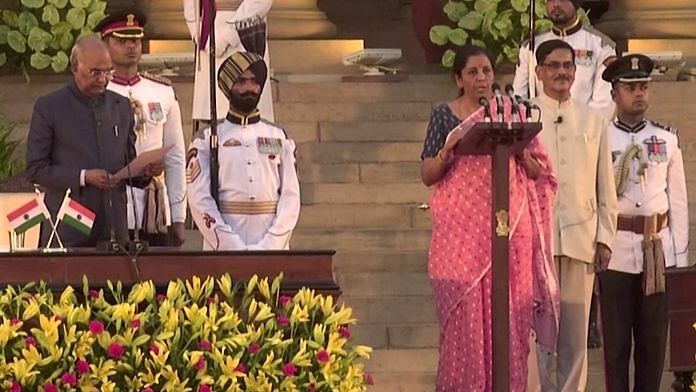New Delhi: A second consecutive year of economic slowdown, a rise in fiscal deficit, global uncertainties, rising unemployment and an imminent crisis in the financial sector will be some of the immediate challenges faced by Nirmala Sitharaman, the new finance minister handpicked by Prime Minister Narendra Modi.
With the announcement of portfolios Friday, Sitharaman becomes the first woman to serve as India’s full-time finance minister, a portfolio Indira Gandhi held briefly during her prime ministership in the early 1970s.
This puts Sitharaman, who handled the sensitive defence portfolio in Modi 1.0, at the helm of one of the most crucial and important ministries.
She is expected to present the first budget of the new government in the second week of July, becoming only the second woman to do so.
This is Sitharaman’s second stint in the union finance ministry, where she served a brief term in the previous Modi administration as minister of state under cabinet minister Arun Jaitley. She was subsequently elevated to the cabinet rank.
She also held the portfolio of commerce and industry in the outgoing Modi cabinet.
Also read: Modi cabinet: Here’s the full list of who got which ministry
On the agenda
A slowdown in domestic growth and consumption, and lack of pick-up in private investment will be some of the immediate challenges for the new finance minister that will have to be addressed in the union budget.
Given the fiscal constraints on account of slowing revenues, the options for Sitharaman to propagate a public investment-led growth are also limited.
India’s economy is expected to further slow down to 6.9 per cent in 2018-19, after a back-to-back quarterly growth slowdown, from 7.2 per cent in 2017-18. The Central Statistics Office will release the full year’s numbers later Friday.
With the electorate opting for continuity, the government will have to continue with the sops announced in the interim budget as well as stick to the fiscal deficit targets.
The government had estimated the fiscal deficit for 2019-20 at 3.4 per cent of gross domestic product after revising the fiscal deficit for 2018-19 to a similar number.
The other contenders
The position of finance minister fell open after Jaitley, who served in the post for most of Modi’s first term, cited health concerns to opt out of the new cabinet.
Among the other contenders for the post was Piyush Goyal, a cabinet minister in the previous government who handled crucial ministries like Coal, Power and Railways, and also had two brief stints as finance minister during Jaitley’s absence on account of illness.
Goyal also presented the interim budget of the union government this year. The budget had marked a departure from previous interim budgets, as it announced a slew of sops, including tax rebates for the middle class.
The name of BJP president Amit Shah was also doing the rounds for the post of finance minister.
A crucial, uncertain juncture
Sitharaman takes over the finance ministry at a critical juncture but will be well served by her experience in the finance and commerce and industry ministries.
The global economic situation is far more volatile as compared to the first stint of the Modi government. Rising oil prices, curbs on Iranian oil imports and the India-US China trade war have all contributed to the rising uncertainties.
Falling crude prices had given the Jaitley-led finance ministry space to undertake subsidy reforms and raise excise duties while keeping retail selling prices of petrol and diesel at acceptable levels. But with rising crude prices, pressure will increase on the government to reduce excise duties on petrol and diesel.
The new minister will also hope for a steady increase in goods and services tax (GST) collections through increasing buoyancy and plugged leaks. While Jaitley’s Finance Ministry successfully implemented GST, the government’s flagship tax reform, the collections have not been as robust as expected. A slowing economy has also adversely impacted direct tax collections from corporates.
Sitharaman will also have to work closely with regulators like the Reserve Bank of India to avert a crisis in the financial sector while finding an effective solution for rising bad debts in the banking sector — a task that remained unfinished under Jaitley.
Spurring labour-intensive manufacturing and addressing rural distress to kickstart consumption will be some other issues Sitharaman will have to address.
Also read: Modi sticks with Harsimrat Kaur Badal, picks her over husband Sukhbir




No need of finance minister in Socialist Bharat, watchman for the minister’s office is enough to give freebies subsidies loan waivers.